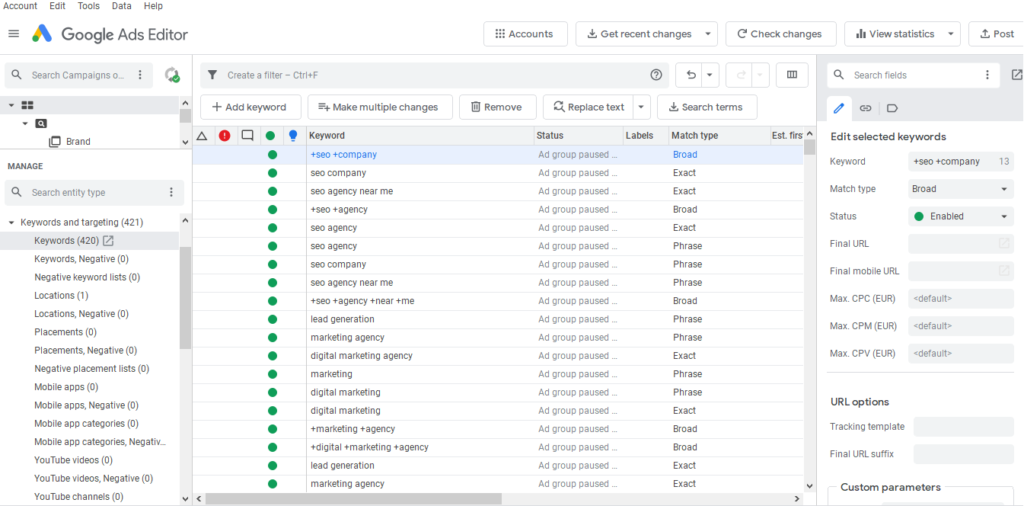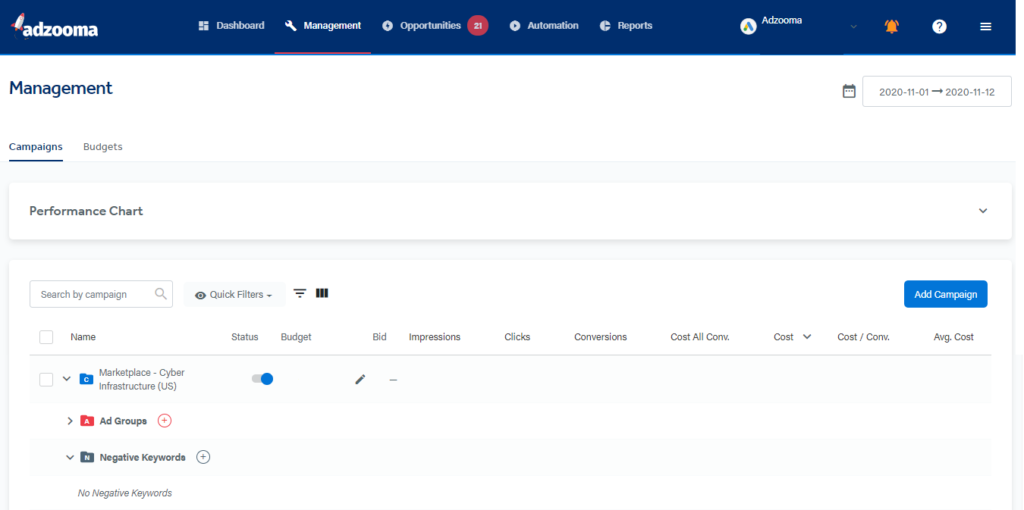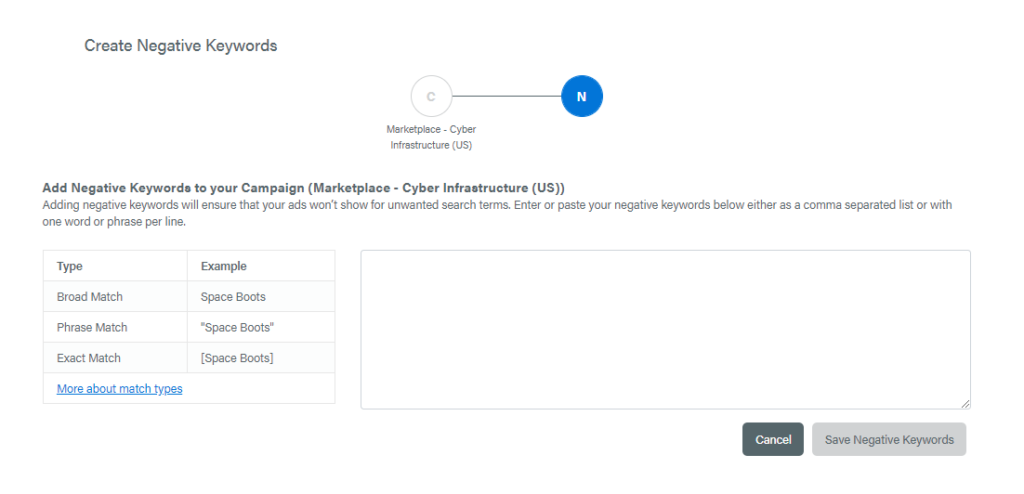One of the easiest ways to save ad spend is to use negative keywords in your Google Ads campaign.
They do this by removing irrelevant search queries from your ad groups, leaving you to focus on the keywords that matter. Refining your ad groups also means better targeting and an increase in return on investment (ROI).
In this guide, we look at how negative keywords work, why they’re important and how Adzooma can help you build powerful negative keyword lists.
What are negative keywords?
Negative keywords are keywords that stop your ads from appearing for certain search queries.
For example, if you sold trees and you added “Christmas” as a negative keyword, that would tell Google Ads to not show your ad for any searches containing the term “Christmas” such as:
- “Christmas trees”
- “Artificial Christmas trees”
- “trees for Christmas”
- “tree toppers for Christmas trees”
This also works on the Display Network, so your ad would appear less on sites where your negative keywords matched a site’s content.
Negative keywords can be added at the account, campaign, and ad group level and understanding how they work can really make a difference.
How do they work?
There’s often a tendency to target all types of keywords related to your business. But that’s not the smart way to use Google Ads. You only want ads to appear for relevant searches where the user is most likely to click and convert. Using negative keywords makes that happen.
With the Christmas example above, an advertiser may look for search terms that are similar to their chosen keywords, but might cater to customers searching for a different product.
Someone might be looking for garden trees but not want Christmas trees, which would be a more popular search term during winter. What’s more, if a business doesn’t stock Christmas trees, they wouldn’t want budget wasted during that time of year.
Note: according to Google, negative keywords don’t match to close variants. So if you exclude a negative broad match keyword “Christmas trees”, you could still appear in a search for “Christmas tree”.
Negative keywords work differently way in Display and Video campaigns compared to Search. There’s also a limit of 5,000 negative keywords and, in some cases, your ad appears may contain excluded terms (this depends on your other keywords in your ad groups and your targeting methods).
Why are they important?
Whatever your campaign goals are, negative keywords are crucial to achieving them. Why? Because they cut down on unnecessary ad spend.
Negative keywords are important as reducing the amount of irrelevant traffic not only helps to reduce wasted spend, but it means that money can then go on keywords which do perform well for your business.
Sophie Logan, PPC Executive at Adzooma
Here are 3 important uses:
1. Avoiding competitor brand terms
There’s a lot of debate around whether advertisers should or shouldn’t bid on competitor brand terms. If you decide against it, negative keywords can come in handy. You could also argue that you don’t want to be associated alongside certain brand terms so Adding potentially sensitive keywords to your list could save you money and branding issues.
2. Specific ad copy for specific audience
Say you have gendered sportswear campaigns. You might not want to display ads for men’s sportswear to people searching for women’s sportswear and vice versa. So in your men’s sportswear campaign, you could include negative keywords such as “women’s”, “ladies” and “female”.
3. Targeting search terms with a higher ROI
A key benefit of negative keywords is to reduce wasted ad spend but it can also amplify campaigns targeting high-coverting keywords.
An example of this would be to add terms like “free”, “low cost”, “cheap”, “reduced” and “discount” to your negative keyword list as users often look for cheaper alternatives for products.
Types of negative keywords
There are 3 main types of negative keywords:
- Negative broad match
- Phrase match
- Exact match
The table below explains them in more detail:
| Negative Keyword Type | Example | Triggered by |
|---|---|---|
| Broad Match | Christmas trees | Broad match negative keywords will stop your advert being shown by any keywords closely related to this term. So, your advert will no longer show up for “Christmas trees”. But.. you’ll also stop showing for “trees not for Christmas”, “trees at Christmas”, “Where is the best place to buy Christmas trees?” etc. |
| Phrase Match | “Christmas trees” | This is similar to board match, except this phrase needs to be used in the search with no words in between. This will stop your ads appearing in searches like “cheap Christmas trees” “best Christmas trees to buy” “top UK Christmas trees”. However, it won’t stop your ad from appearing in searches like “best trees to buy for Christmas”. |
| Exact Match | [Christmas trees] | Exact match keywords only show when the exact term is searched for, in that the exact order. So, your ads won’t show for “Christmas trees”, but it won’t prevent your advert showing for searches such as ‘trees at Christmas’. |
How to build a negative keyword list
In Google Ads Editor
Open Google Ads Editor, ensuring that you fetched recent changes and scroll down to the ‘Manage’ bar until you reach ‘Keywords and Targeting’.

Opening up the tab will bring up a wide range of keyword and targeting options, but for this task we want to click on ‘Keywords, Negative’.
- Click ‘Add Negative Keyword’
- Choose what level you want to assign the negative keyword to. Ad group level will assign it to the ad group selected only, with Campaign level assigning them to the campaign of choice.
- After selecting the level you want to assign your negative keyword to, you will be able to add and edit the type of negative keyword you would like to add. You will need to select the match type. For example: If you don’t want your ads to show for the term ‘free’ then you would want to add this as a negative keyword.
- Continue adding in negative keywords.
- Once finished make sure you click ‘Post’ to push your changes live to your account.
In the Adzooma platform
Creating negative keyword lists in the Adzooma platform is much simpler.
Log into the platform and navigate to the ‘Management’ page.

- Next to ‘Negative Keywords’, click ‘+’

- Simply pop your negative keywords into the box, along with the relevant match type symbols and click save.

Your negative keywords will now appear in your negative keyword list!
How to find negative keywords
If you’re struggling to figure out what negative keywords you should use for your Google Ads campaign, consider the following:
1. Use lists of common negatives
Do a Google search and you’ll find a host of lists featuring common negative keywords.
What negatives you uses depends on your industry and campaign goals but some general eCommerce keywords include:
- Free
- Used
- Cheap
- Low cost
- Bargain
- Bargains
- Deal
- Deals
- Discount
- Discounts
2. Analyse your search terms report
The best Google Ads data is your own data so make sure to study your search terms report to identify ad spend leaks.
The search terms report shows the terms that people searched for to trigger your ads. This data can give ideas for negative keywords, particularly if you spot unrelated terms in the report.
But remember: negative keyword match types don’t match to variants so make sure you factor that in when you add new negatives to your list.
3. Use Google Autocomplete
When I type in “tree” I get the following from Google’s autocomplete search feature:
- trees
- treesize
- treesize tool
- trees for sale
- trees for small gardens
- trees for life
- trees for sale near me
- trees for sale nottingham
- trees in pots
- trees online
Some of those terms are relevant but others aren’t. Manual searches find this immediately but the bigger your campaign, the longer it takes. So you have options to automate this process with a keyword tool like Mangools KWFinder or you could use SEMrush or SEO PowerSuite to find similar suggestions.
Need help? Let Adzooma manage your negative keywords
Negatives can be positives with Adzooma, with the inclusion of our negative keywords feature. It’s a fantastic way to manage your budget, make better targeting decisions, and boost your return on investment.
You can now add, edit and view all negative keywords at campaign and ad group level within the platform. Simply log into your account and find negative keywords in your management screen.
But if you’re not an Adzooma customer yet, there’s never been a better time to join as our platform is free.



